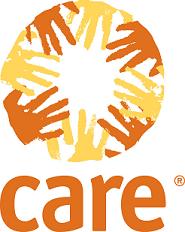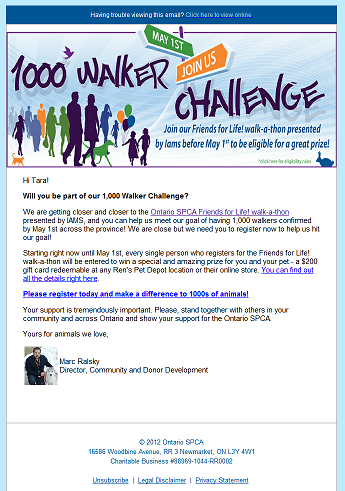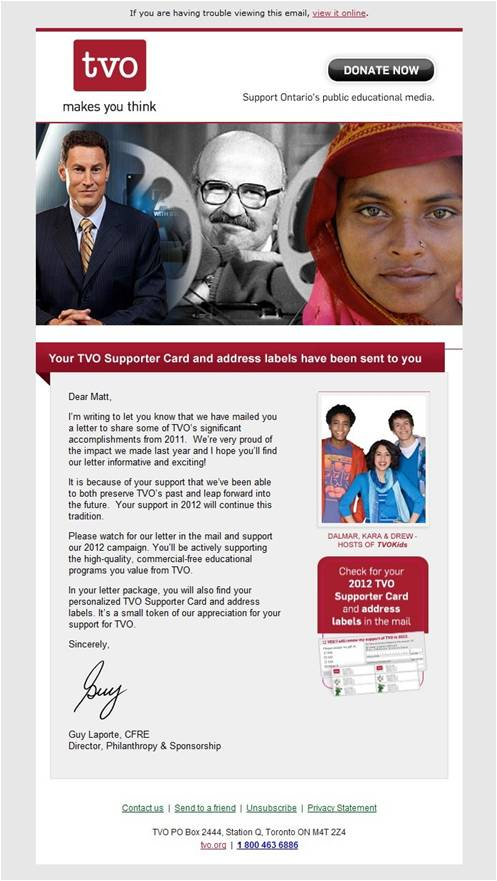
Spotlight on Integrated Marketing Award Winner: CARE
The past two weeks, I highlighted two case studies of winners of the Integrated Marketing Advisory Board’s 2012 Integrated Marketing Awards -- TVO and Ontario SPCA. Today, I’m excited to spotlight the third and final winner, CARE.
 CARE, a leading humanitarian organization fighting global poverty, won in the category of The Donor for demonstrating how an integrated marketing campaign or program had an impact on donor satisfaction and the donor experience. The organization used coordinated mail and email invitations and follow-ups to extend their annual donor conference call to an audience beyond their traditional direct mail donors.
CARE, a leading humanitarian organization fighting global poverty, won in the category of The Donor for demonstrating how an integrated marketing campaign or program had an impact on donor satisfaction and the donor experience. The organization used coordinated mail and email invitations and follow-ups to extend their annual donor conference call to an audience beyond their traditional direct mail donors.
Here is an overview of the program:
The Challenge
Donors engage with CARE in many ways -- by making a gift, signing a petition, interacting via social media, etc. By engaging donors in multiple ways, CARE is able to increase donor retention and, ultimately, revenue. In the past, CARE’s annual donor conference call has been limited to their high value donors, positioning it as a thank you for their extraordinary support. This year, CARE determined that the donor conference call was an under-used opportunity to further engage supporters across channels.
The Campaign
CARE hosts an annual donor conference call with their President, Dr. Helene Gayle, and an audience of high value donors. Invitations are sent in the mail, with call-in instructions provided. The purpose of this call is stewardship -- an opportunity for donors to interact personally with Dr. Gayle and CARE.
This year, CARE broadened the conference call audience, extending the invitation to a select group of online donors and non-donors. Qualifying supporters received an email invitation with the conference call details as well as a reminder the day before. For the call itself, donors heard first-hand from Dr. Gayle and other members of the CARE team as they described their work and efforts in a particular area. At the end, donors were encouraged to ask questions about the topic at hand, or about any of CARE’s work. Following the call, donors received an email and mailed follow-up thanking them for attending and, for those that did not attend, providing a brief recap of what was discussed.
The Results
As a stewardship opportunity, it is difficult to measure the exact impact of the conference call. However, overall, the call was perceived as highly favorable -- both by the internal staff at CARE and by those supporters that dialed in for the call. Call attendance was 75% higher than it had been in the past and was split relatively evenly between donors and non-donors.
Spotlight on 2012 Integrated Marketing Award Winner: Ontario SPCA
In August 2012, the Integrated Marketing Advisory Board announced three award winners for our first-ever Integrated Marketing Awards. The Ontario SPCA, one of the largest animal welfare organizations in Canada, won in the category of The Organization, demonstrating how an effort across the organization aligned strategy, structure, culture, and skills to impact the organization’s ability to integrate its marketing efforts. Following is the program for which the Ontario SPCA won the award:
The Challenges
Before 2012, the Ontario SPCA faced several challenges:
- Different brands and sponsors for community branches across Ontario
- Different event dates for each community event
- Different prize/incentive programs
- No customer service model
- Little province-wide marketing opportunities for 2012
The Campaign In 2012, the Ontario SPCA developed an integrated marketing strategy to support their province-wide Friends for Life! walk-a-thon event. The provincial office worked with community branches to build a singular event brand and communicate to participants, donors and prospects across all media channels in Ontario. Marketing strategy included email, online advertising and social media combined with the traditional channels of telephone, postal mail, radio, television and print to appeal to diverse audience across Ontario.
In 2012, the Ontario SPCA developed an integrated marketing strategy to support their province-wide Friends for Life! walk-a-thon event. The provincial office worked with community branches to build a singular event brand and communicate to participants, donors and prospects across all media channels in Ontario. Marketing strategy included email, online advertising and social media combined with the traditional channels of telephone, postal mail, radio, television and print to appeal to diverse audience across Ontario.
Audiences were driven to the newly redesigned event website. Effectively using the event website, updated event logo and a comprehensive integrated marketing strategy across all channels helped the Ontario SPCA to increase donations and recruit and engage participants.
When registration for the spring 2012 walks plateaued at around 675 participants, the Ontario SPCA saw this as an opportunity to run the 1,000 Walker Challenge, a mini-campaign aimed at recruiting a thousand participants for the spring walk events.
This mini-campaign included:
- Button on event website homepage
- Two-part email series to promote the mini-campaign with call to action: Please register today and make a difference to thousands of animals!
- Promotion through social media: Draw for gift card at a pet store as incentive to register
The email series was sent on April 17 and April 28, and the Ontario SPCA reached their mini-campaign goal of 1,000 participants by May 1. This unique mini-campaign was successful because of the integrated elements combined with a fun incentive that was appealing for both people and their pets. The Ontario SPCA plans to include this challenge in their integrated marketing strategy for the 2013 event.
The Results
- Funds raised online as of October 2012: $259,269 (Event fundraising goal will be totaled following the fall 2012 events.)
- Total Participants Increase during TV and radio campaign April-May 2012: 287
- Total Donation Increase during TV and radio campaign April-May 2012: $54,032
- 1,000 Walker Challenge mini-campaign recruited an additional 325 participants in two weeks, helping the Ontario SPCA reach their goal of a thousand walkers for the spring events
Spotlight on 2012 Integrated Marketing Award Winner: TVO
In August 2012, the Integrated Marketing Advisory Board announced three award winners for our first-ever Integrated Marketing Awards. The awards are a way for us to recognize examples of the sector’s successful use of integrated, multi-channel marketing campaigns or programs.
TVO, Ontario's public education media organization, won in the category of The Practice for sharing its real world case study highlighting best practices in the field of integrated marketing. Here is a look at the program for which TVO won the award:
The Challenges
TVO had been experiencing a number of years of decline in numbers of donors and total revenues:
- 2nd gift conversion dropped from 83% to 30%
- Net loss of donors since 2005
- Lifetime value of donors decreasing significantly since 2001
- The TVO magazine, which was the primary stewardship vehicle, stopped in 2007
The Campaign
 TVO created an integrated plan from the ground up and saw it through to the end. Their plan represented true integration, involving: direct mail, email, web, television, telephone and face-to-face channels -- all with the same messaging, and all working together to retain current donors and acquire new ones. The organization now is building on the success of its integrated plan to continue integration in all fundraising and marketing activities.
TVO created an integrated plan from the ground up and saw it through to the end. Their plan represented true integration, involving: direct mail, email, web, television, telephone and face-to-face channels -- all with the same messaging, and all working together to retain current donors and acquire new ones. The organization now is building on the success of its integrated plan to continue integration in all fundraising and marketing activities.
Here’s how TVO integrated all aspects of its annual plan to create a seamless donor experience:
- The development of a quarterly Impact Report, which was integrated with a holiday ask
- Creation of a new fundraising microsite which
was integrated with current direct mail, on-air,
and on-line initiatives - A pledge/email welcome/conversion cycle to acquire new donors
- A direct mail renewal cycle integrated with telemarketing and online activities
- New cultivation direct mail appeals focused on
the holidays and 40th anniversary - Integrated on-air and online spots promoting
the new cultivation campaigns and renewal cycle - Direct mail/online integration: timely pre-direct mail email, and then timely post-direct mail email both in three different versions
- The implementation of new fundraising acquisition vehicles such as face-to-face and on-air
- The introduction of an industry-leading fundraising database to track and maintain accurate records and new online relationship-management system
The Results
- Donor decline ended and stabilization was achieved
- Quarter-by-quarter, TVO’s income was up between 26-40% over the previous year
- TVO enjoyed its best quarter since 2006
- Achieved these results with a relative modest budget maximized through leveraging integration
- Integrated campaign has been used as a case study in fundraising conferences
Integrated Marketing Doesn't Always Mean Using Multiple Channels
When we talk about integrated marketing, we often look at integrating multiple communication channels for each campaign. But sometimes, integrated marketing can be as simple as coordinating multiple communications using a single channel. And, it can still be very effective.
 For example, last year, Avalon worked with the animal welfare charity,
For example, last year, Avalon worked with the animal welfare charity,
Farm Sanctuary, on an online campaign to convert monthly donors. It was a huge success, proving that with an eye for integrating communications, the online
channel can be an excellent tool for fundraising.
The Objective
The primary objective in this campaign was to acquire 150 new sustainers (monthly donors) for Farm Sanctuary to secure reliable funding for rescues, current projects and ongoing maintenance. The campaign aimed to successfully use the online channel, which is typically a cheaper method of acquiring monthly donors, but often not as effective as telemarketing.
The Strategy
In order to reach this ambitious goal, the campaign took a new approach to Farm Sanctuary’s traditional and more institutional sustainer invite. Though Farm Sanctuary had previously seen moderate success converting donors into sustainers using a premium offer, we wanted to determine whether a rescue and emotionally-charged story could better make the case for sustained monthly giving.
Three emails with coordinated links on the homepage were sent to give members several opportunities to make the decision to join as a sustainer and to build the case with growing urgency. A goal for the number of new sustainers was stated in each of the emails in order to drive donors to be part of a larger contribution. With this goal there was also a deadline just a few weeks away from the first send in order to create a sense of urgency. But in order to make a case for sustained monthly giving, Farm Sanctuary had to focus on ongoing needs as well as urgent ones. We focused each of the emails on the moving tale of an individual animal, making a personal and compelling appeal, and accompanied by strong imagery to compel donors and draw them in on an emotional level.
Lastly, the campaign emphasized the ease of monthly giving, since the commitment can be difficult to negotiate without the advantages of telemarketing. The use of symbolic asks was included to demonstrate how little a sustainer would be donating on a daily basis despite the large contribution overall.
The audience consisted of donors with email addresses, but with high dollar donors and current sustainers suppressed.
The Results
The results surpassed even our greatest expectations. Of the 330 total gifts received, 254 of those gifts were monthly gifts. The overall response rate for the campaign was 0.20%, very strong by industry standards and exceptional for a monthly giving campaign. This campaign netted revenue from the start, as opposed to a traditional telemarketing invite which could return the investment anywhere from 2-8 months.
This is a clear example of the impact of a coordinated campaign using a single channel. With over 250 new monthly givers in a three-effort email campaign, it is clear that the online channel can be a valuable tool when used well.
Share, Like and Post | | Article Link | CommentThe Social Side of Managing Change for Integrated Marketing
 This post was written by Andrew Shoaff, Director, Interactive Strategy Practice, Blackbaud.
This post was written by Andrew Shoaff, Director, Interactive Strategy Practice, Blackbaud.
Integrated marketing encompasses far more than just the use of multiple channels in a campaign. It also involves people working in an integrated way across an organization. For many nonprofits, this means changing how their organization “touches” their supporters -- from approaching constituent-facing communications in a more integrated fashion to coordinating who owns the supporter experience within the organization.
As you approach integrated marketing within your organization, it’s important to consider how you’ll handle this change. One thing to think about is the importance of social influencers on your staff.
Our friends, colleagues and peers often have the greatest influence in our decisions to act. It’s a concept at the heart of change management philosophy -- successful change efforts result when people consciously and sincerely make the decision to embrace change rather than when it is forced upon them. With this in mind, and when faced with a transformational process, nonprofit leaders are wise to enlist and develop Change Champions whose social and professional influence drives others to fully embrace a new direction.
Sounds good, but how do you identify the right people for the Change Champion job? What will they do in your change process, and how do you enable the kind of leadership and advocacy you expect?
Let’s start with the “who.” Using the example of technology adoption, think about who in the organization will use the product most and who stands to gain from the new product on a day-to-day basis. This is your most important audience -- the group that will ultimately define the success of your initiative. Look to this body to find champions:
- Think first about who would be a natural fit. Have any early adopters in the group -- people who were using @ mentions and hashtags while you were still trying to figure out how to get email on your phone? Early adopters can be great Change Champions, as they understand how a product or service fits into a larger context of technology change happening around the organization.
- Next, consider individuals who have unique knowledge or expertise regarding the existing process or product. The credibility of Change Champions is imperative to the group’s influence, and the presence of subject matter experts helps define that credibility.
- Finally, think about detractors. Who in the group has a lot of personal influence, but already doesn’t like what’s about to happen? There are people who many never change their mind no matter the evidence or rationale. Forget about these guys. Rather, look to someone whose opinion is valued in the wider group and who has the clarity of mind to see the value in something new. Getting someone like this on the side of a change effort can have enormous impact in how and when others decide to get on board.
To be most effective, Champions need an important role in the process. The more voice and ownership they have, the more sincere their interest in the outcome. Charge champions with detailing what the product or service needs to do and the internal processes to which it needs to align. The following is a list of responsibilities and decisions I try to lead Champions through during a change process:
- Identify realities of the organization that act as barriers to success.
- Validate the list of product or process requirements, as they are ones most familiar with the minutia of the organization’s day-to-day operations.
- Identify detractors in the organization -- those not part of the Change Champion group -- and develop a plan to help explain the value of the product or service and why it’s something they should want to embrace.
- Own testing of the product. If it doesn’t work the way it’s supposed to or the way you thought it would, this is the right time to speak up and affect the end solution.
- Help train the rest of the organization. It’s one thing for a consultant to swoop into town and explain how any why to use something. But, the level of influence can be altogether different if it’s a peer helping you learn something new.
Just as integrated marketing has a long history, social networks have been around since long before we ever put a name to them. Be sure to remember that within your organization, influence in those social networks is a complex formula. Ultimately, the decision to embrace something new -- such as integrated marketing -- is something each person makes for themselves. But, the decision is made much easier when you have the most influential people in the room on your side.
Share, Like and Post | | Article Link | Comment

















